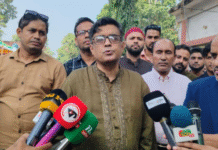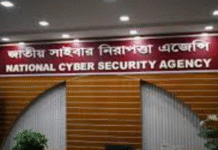The vanished canals were filled up and grabbed by 10,500 grabbers with political power
Until only three decades ago, Dhaka had over 50 canals and lakes and was surrounded by four rivers and wetlands. Over the years, however, the capital and largest city of the country has lost almost all of it.
The major part of Dhaka’s drainage system consists of canals, rivers and lakes that help reroute extra water out of the city. There is also a storm drainage network of around 261 sq km around the city.
The two main reasons behind the disappearing canals are the creep of construction and the dumping of massive quantities of garbage from the surrounding neighbourhoods.
The authorities concerned have long ignored the illegal encroachment upon the canals and have failed to re-excavate, demarcate and properly monitor their condition.
The major canal systems in and around the capital are the Degun–Ibrahimur–Kallyanpur canal that drains out to the Turag River, the Dhanmondi–Paribagh–Gulshan–Banani–Mohakhali–Begunbari canal that drains out to the Balu River, and the Segunbagicha–Gerani–Dholaikhal canal that drains out to the Balu and Buriganga rivers.
According to urban planners, historians and government data, Dhaka used to have 65 canals, and over 50 were still flowing until as recently as the early 1980s. However, that number has fallen to 43 today with around 20 of these under threat due to encroachment.
The Dhaka Water And Sewerage Authority (Wasa) maintains 26 canals for the drainage system, although they are owned by Dhaka Deputy Commissioner’s (DC) Office.
Of the other 17 canals, nine have been covered by roads, box culverts and brick sewerage lines and another eight remain under the jurisdiction of the DC office, according to a report of Dhaka North City Corporation (DNCC).
Concerns over the shrinking drainage canals have been acted upon before. In 2008, Dhaka Wasa took initiatives to reclaim the 26 canals from illegal occupation by building walkways and channels and by planting trees along the canal embankments.
A Wasa official told the Dhaka Tribune that the project was not implemented properly: “A Wasa report published in 2010 shows that the vanished canals were filled up and grabbed by 10,500 grabbers with political power,” he said.
When asked about the poor condition of the 26 canals, Local Government, Rural Development and Cooperatives (LGRD) Minister Khandker Mosharraf Hossain said the government had undertaken a project aimed at recovering all of Dhaka’s canals from grabbers and has formed an independent task force in this regard.

Experts say the filled-in canals are a major cause of the excessive waterlogging seen in the capital from May to October every year. During this year’s monsoon, the situation has worsened and the city remains under threat of flooding as major rivers are flowing above the danger level across the country.
The Dhaka Wasa and the DNCC say the present conditions – length, width and depth – of the existing 26 canals are very poor.
The Rupnagar canal in Mirpur used to be 6km long and 3-8m wide, but it has been narrowed down to almost nothing by illegal structures built along its banks. This correspondent found shanties lining both sides of the canal and massive amounts of waste in the water.
The canal’s disappearance has been simultaneous with increasing waterlogging problems in the area. Mirpur has been under water for most of the monsoon this year, hampering daily commutes to and from the capital’s biggest residential neighbourhood.
Other canals in Mirpur that have almost disappeared are the 460m-long and 30m wide Baishteki canal, the 2.4km-long Sangbadik Colony canal, the 8.8km-long and 10-12m wide Baunia canal, the 4.5km-long and 50m wide Digun canal, the 1.1km-long Mirpur Section 14 housing canal, and the 1.26km-long Ibrahimpur canal.
The Baunia canal is almost entirely filled with solid waste. From the Turag River to Sagufta Housing, and from Mehedibagh to Kalshi, the canal has been filled up and built upon, leaving a pipe of only 90cm in diameter to discharge rainwater.
A number of multistorey buildings, walls, and tin-shed houses among other illegal establishments have been built on the Ibrahimpur canal, narrowing it down to 9m from 30m in several places.
Waterlogging at the residential areas of Kallyanpur, Shyamoli and the surrounding areas has been a regular feature of the last couple of years. A Shyamoli resident said the prolonged waterlogging with sewerage water was having an adverse impact on the lives and health of the people there.
According to a 2007 Dhaka Wasa survey, the 2.2km Kallyanpur main canal was 18-36m wide. Encroachment by land-grabbers has narrowed the width of the key drainage route down to 10-12m in places.
This correspondent found that various establishments had been built near the banks of the canal adjoining the Hazi Market at North Shyamoli, and also on both sides of the Kallyanpur sluice gate, violating the Wetland Conservation Act and the Dhaka Detailed Area Plan (DAP).

Several illegal bamboo structures were seen on the Kallyanpur main canal. The dumping of non-degradable waste, such as polythene bags, has also reduced the depth of the water body to 7-8m.
Illegal structures continue to grow on the canal’s five branches – Kallyanpur Ka, Kha, Gha, Unwa and Cha canals.
On the Katasur canal, illegal buildings have cropped up on 150 square metres on both sides, and most of the canal is filled with solid waste.
A mosque has been established on the southern part of the Number 3 road culvert near Mohammadpur and Nobodoy Housing in the city.
The nearby 2.94km-long Ramchandrapur canal, which used to be 18-30m wide, has lost its natural flow due to rampant construction and the persistent dumping of waste.
“The canal has now become a breeding ground for mosquitoes,” said Ashik Anwar, a resident of Mohammadpur.
A multistorey building has been built on the canal near the Dhaka Wasa water pump station, while the city corporation has built a 10m wide road by filling up the canal.
Source: Dhaka Tribune











